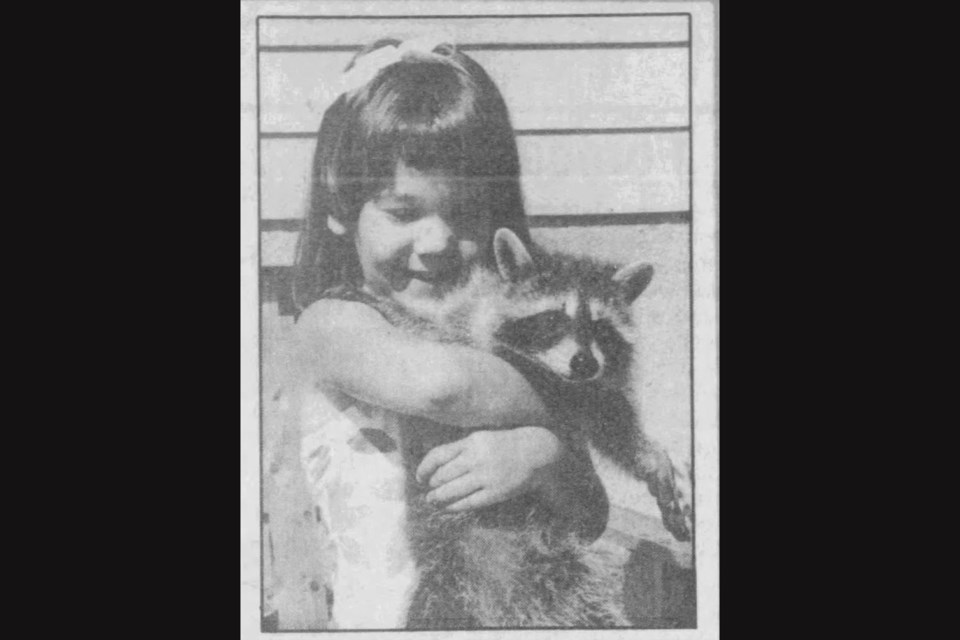From the archives of the Sault Ste. Marie Public Library:
Do you remember the animated television show about a furry-tailed critter with a mask?
The television show in question is none other than The Raccoons, which ran from 1985 until the spring of 1991.
Originally, the program appeared as a one-hour special that occurred now and again but made a switch to a recurring half-hour program. This change also altered how the producers viewed the characters and how they developed storylines; they saw it as an opportunity. Kevin Gilles, the director and producer of The Raccoons, said, “we’re getting away from cardboard characters and slam-bang action into more subtle relationship situations” (Sault Star, October 2, 1987, p.35). We were able to gain a more intimate relationship with raccoon characters Bert Raccoon and Cyril Sneer, and be introduced to supporting characters. The move to develop the characters more thoroughly reflects what other animated series implemented to be successful, most notably a family from Springfield.
The development of more complex characters made a lot of sense on several levels. One of the reasons is that for viewers to consistently tune in, you want them to grow an attachment to the character or characters. The second is that raccoons are, in fact, complex critters, as described by the residents of the area who have had many encounters with the masked woodland creatures. On one hand, raccoons are often portrayed as ‘cute’ creatures that can be ‘mischievous’ in wildlife programs or sitcoms such as The Racoons. On the other hand, some residents would argue that they are more than mischievous and label them pests.
If you have ever had the opportunity to feast your eyes on a baby raccoon, you would surely have a hard time denying that it is a cute creature. It would even be harder not to feel empathy towards them when they are orphaned. This was the case with Colleen McLean’s family, when a family of six raccoons decided to make a den between their roofs. Despite the raccoons sounding like ‘squealing monkeys,’ Colleen “didn’t want to do anything that would hurt the baby raccoons” (Sault Star, June 12, 1995, p.9). The Humane Society told the McLean family that if they were able to capture the mother, the babies would most likely follow, but to their dismay, they were left with orphaned raccoons.
Thankfully, after a few attempts by neighbouring children to remove the orphans, a young Derek Dubé was able to retrieve them by crawling into the area in which they made their den, armed with nothing but gardening gloves. You are probably thinking, what happened to the orphaned woodland creatures? Were the McLeans able to get some sleep after the noisemakers were removed?
The answer to the second question was yes, the McLeans were able to return to the main level of their home after living in their basement while the raccoons took up tenancy in the roof. The baby raccoons made it out okay as well after being relocated by the Humane Society to be raised until they were able to fend for themselves.
In cases such as these, the Humane Society would issue a permit to foster an exotic pet, which a raccoon would surely classify as. It was important for the orphaned raccoons’ survival because they “can be vulnerable if left unattended in the wild” (Sault Star, August 9, 1986, p.31). Unlike the McLean family, however, the Colgate and Adams families fostered orphaned raccoons willingly, relocating them after they were less vulnerable. In all cases, they did not want the defenceless woodland creatures to suffer.
The Colgate and Adams families learned a lot during the summer of 1986. When the orphaned raccoons arrived, they were essentially infants, unable to find food and fend for themselves. Like how baby cows are bottle fed when the mother is unable, the Colgate family had to find a way to feed the defenseless raccoon. In the early stages of their foster care, they had to feed ‘Bandit’ via an oral syringe to ensure he received the nutrients needed. After the houseguest developed, they became easier to host, as the animals are not overly picky eaters.
Ashleigh Adams, Cindy Colgate, and Julie Colgate learned that raccoons are complex creatures. While they “heel right with you, right behind your leg” (p.31), raccoons are wild animals and come with their own challenges. Those of us that have had puppies in the past know that house training presents challenges, even for a domesticated animal. Despite the raccoons being cuddly and good for walks, they were unlikely to stay cooped up in a pen for extended periods of time. Similarly, Mrs. Colgate suggested that housebreaking a raccoon was next to impossible, as “they go when they want” (p.31), which would imply that they went wherever they wanted as well. That is possibly the reason the girls took them wherever they went, for walks and swimming for instance.
Just like the characters of the show The Raccoons, wild raccoons are not two-dimensional and can be polarizing characters. They can be ‘great engineers’ on the one hand, and ‘30 pounds of dynamite’ on the other, as described by Mr. Colgate. They can be cute and cuddly, but bite you if you don’t respect them. If given a chance, would you foster one of these ‘mischievous houseguests’?
Each week, the Sault Ste. Marie Public Library and its Archives provide SooToday readers with a glimpse of the city’s past.
Find out more about what the Public Library has to offer at www.ssmpl.ca and look for more "Remember This?" columns here.
